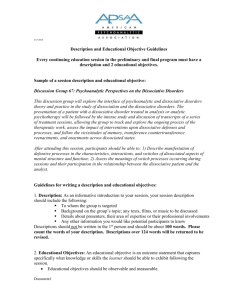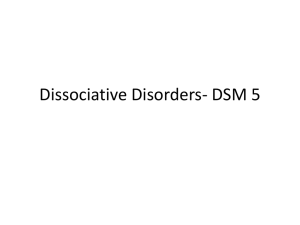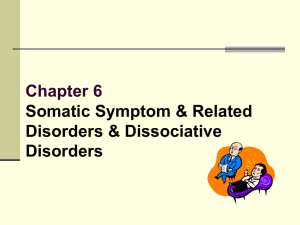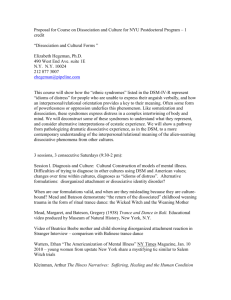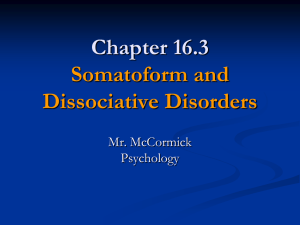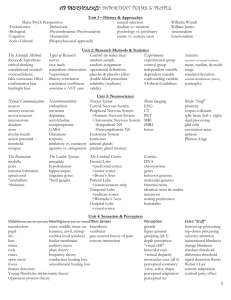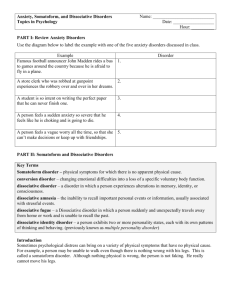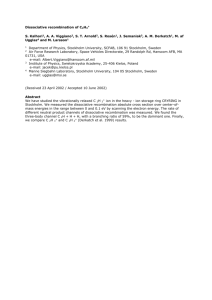recognizing the validity of dissociative symptoms using the scid-dr
advertisement
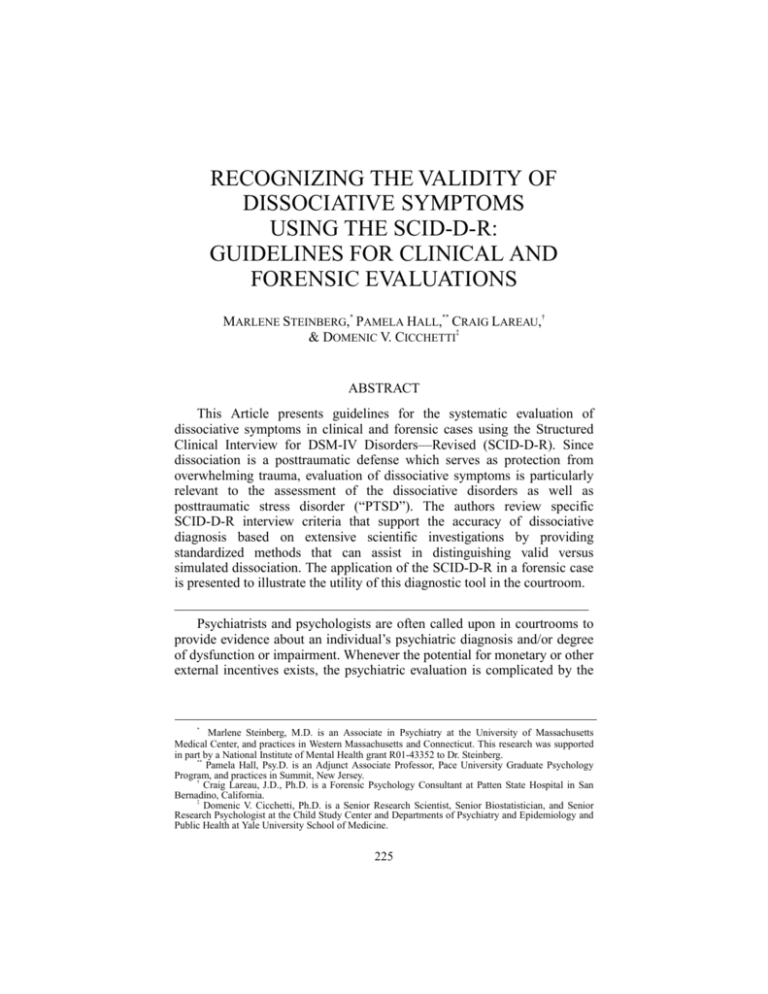
RECOGNIZING THE VALIDITY OF DISSOCIATIVE SYMPTOMS USING THE SCID-D-R: GUIDELINES FOR CLINICAL AND FORENSIC EVALUATIONS MARLENE STEINBERG,* PAMELA HALL,** CRAIG LAREAU,† & DOMENIC V. CICCHETTI‡ ABSTRACT This Article presents guidelines for the systematic evaluation of dissociative symptoms in clinical and forensic cases using the Structured Clinical Interview for DSM-IV Disorders––Revised (SCID-D-R). Since dissociation is a posttraumatic defense which serves as protection from overwhelming trauma, evaluation of dissociative symptoms is particularly relevant to the assessment of the dissociative disorders as well as posttraumatic stress disorder (“PTSD”). The authors review specific SCID-D-R interview criteria that support the accuracy of dissociative diagnosis based on extensive scientific investigations by providing standardized methods that can assist in distinguishing valid versus simulated dissociation. The application of the SCID-D-R in a forensic case is presented to illustrate the utility of this diagnostic tool in the courtroom. ____________________________________________________________ Psychiatrists and psychologists are often called upon in courtrooms to provide evidence about an individual’s psychiatric diagnosis and/or degree of dysfunction or impairment. Whenever the potential for monetary or other external incentives exists, the psychiatric evaluation is complicated by the * Marlene Steinberg, M.D. is an Associate in Psychiatry at the University of Massachusetts Medical Center, and practices in Western Massachusetts and Connecticut. This research was supported in part by a National Institute of Mental Health grant R01-43352 to Dr. Steinberg. ** Pamela Hall, Psy.D. is an Adjunct Associate Professor, Pace University Graduate Psychology Program, and practices in Summit, New Jersey. † Craig Lareau, J.D., Ph.D. is a Forensic Psychology Consultant at Patten State Hospital in San Bernadino, California. ‡ Domenic V. Cicchetti, Ph.D. is a Senior Research Scientist, Senior Biostatistician, and Senior Research Psychologist at the Child Study Center and Departments of Psychiatry and Epidemiology and Public Health at Yale University School of Medicine. 225 226 Southern California Interdisciplinary Law Journal [Vol. 10:2 necessity to rule out malingering.1 As with other psychiatric diagnoses, the forensic expert in cases of dissociation should utilize data from the individual’s clinical history, past records, specialized diagnostic testing, as well as corroborative information in distinguishing between real or malingered dissociation. Recent advances in the field of dissociation have included the development of reliable specialized diagnostic tools and screening tests, as well as a surge of scientific investigations documenting the diagnostically distinguishing features of dissociative disorders as compared to nondissociative disorders.2 These investigations provide essential diagnostic tools and reference material for clinicians involved in treatment settings, as well as for forensic evaluators. Though several recent lawsuits involved allegations of iatrogenically induced dissociative identity disorder (“DID”), it is important to note that there is no scientific evidence that: (1) DID and the entire range of complex core symptoms can be implanted or simulated, or (2) DID can be simulated more easily than any other psychiatric or medical disorder. Though isolated symptoms may be endorsed (and investigators have attempted to extrapolate the results to DID), no investigation has documented the simulation of the entire array and complexity of symptoms necessary for the diagnosis of DID.3 For example, identity alteration in DID is characterized by its complexity, distinctness, chronic course the ability of the states to take control of behavior, and the interconnection with other 1 Malingering refers to the intentional production of psychological symptoms in the presence of external incentives. 2 See generally MARLENE STEINBERG, INTERVIEWER’S GUIDE TO THE STRUCTURED CLINICAL INTERVIEW FOR DSM-IV DISSOCIATIVE DISORDERS––REVISED (SCID-D-R) (1994) [hereinafter STEINBERG I]; MARLENE STEINBERG, THE STRUCTURED CLINICAL INTERVIEW FOR DSM-IV DISSOCIATIVE DISORDERS––REVISED (SCID-D-R) (1994) [hereinafter STEINBERG II]; MARLENE STEINBERG & MAXINE SCHNALL, THE STRANGER IN THE MIRROR: DISSOCIATION—THE HIDDEN EPIDEMIC (2000); Jon G. Allen, Introduction to Advances in Diagnosing and Treating Trauma, 64 BULL. OF THE MENNINGER CLINIC 143 (2000); Eve M. Bernstein & Frank W. Putnam, Development, Reliability and Validity of a Dissociation Scale, 174 J. NERVOUS & MENTAL DISEASE 727, 727–32 (1986); Ellert R.S Nijenhuis, Philip Sinhoven, Richard van Dyck, Onno van der Hart, & Johan Vanderlinden, The Development and the Psychometric Characteristics of the Somatoform Dissociation Questionnaire (SDQ-20), 184 J. NERVOUS & MENTAL DISEASE, 688, 688–94 (1996); Kevin Riley, Measurement of Dissociation, 176 J. NERVOUS & MENTAL DISEASE 449, 449–50 (1988); Marlene Steinberg, Advances in the Clinical Assessment of Dissociation: The SCID-D-R, 64 BULL. OF THE MENNINGER CLINIC 146 (2000) [hereinafter Steinberg III]. 3 See generally DANIEL BROWN ET AL., MEMORY, TRAUMA TREATMENT AND THE LAW: AN ESSENTIAL REFERENCE ON MEMORY FOR CLINICIANS, RESEARCHERS, ATTORNEYS, AND JUDGES (1998); Daniel Brown, Edward Frischholz, & Alan W. Scheflin, Iatrogenic Dissociative Identity Disorder–––An Evaluation of the Scientific Evidence, 27 J. PSYCHIATRY & L. 549 (1999); David H. Gleaves, The Sociocognitive Model of Dissociative Identity Disorder: A Reexamination of the Evidence, 120 PSYCHOL. BULL. 42 (1996); R.P. Kluft, The Simulation and Dissimulation of Multiple Personality Disorder, 30 AM. J. CLINICAL HYPNOSIS 104 (1987); Nicholas P. Spanos, John R. Weekes, & Lorne D. Bertrand, Multiple Personality: A Social Psychological Perspective, 94 J. OF ABNORMAL PSYCHOL. 362 (1985). 2001] Recognizing the Validity of Dissociative Symptoms 227 dissociative symptoms assessed in the Structured Clinical Interview for DSM-IV Dissociative Disorders––Revised (SCID-D-R).4 The purpose of this Article is to introduce guidelines for the use of the SCID-D-R in forensic evaluations and precise criteria to support the accuracy of dissociative disorder diagnosis. These guidelines were developed based on the review of over five hundred SCID-D-R interviews conducted with psychiatric patients (with dissociative and non-dissociative disorders), normal controls, and persons simulating DID. The clinical application of the SCID-D-R in a forensic case is presented to illustrate the utility of this diagnostic tool in the courtroom. I. THE STRUCTURED CLINICAL INTERVIEW FOR DSM-IV DISSOCIATIVE DISORDERS-REVISED (SCID-D-R) The SCID-D-R is a clinician-administered interview that evaluates the severity of core dissociative symptoms, and diagnoses the dissociative disorders based on DSM-IV criteria.5 The severity of dissociative symptoms can be assessed in patients with a variety of psychiatric disorders and is particularly relevant to patients with dissociative disorders and PTSD. The SCID-D-R assesses dissociation through the assessment of key features of five core dissociative symptoms (amnesia, depersonalization, derealizations, identity confusion, and identity alteration), including frequency, nature, and severity. Recognized as the “gold standard” for the diagnosis of the dissociative disorders, the SCID-D-R has a wide variety of clinical applications including its utility as a diagnostic tool for adolescents and adults, as well as its utility for treatment planning.6 Also, since patients with PTSD experience key dissociative symptoms (including amnesia, depersonalization, and derealization), the SCID-D-R can also provide evidence supporting the validity of dissociation in patients with PTSD. The SCID-D-R was constructed to standardize the assessment of dissociative symptoms and disorders by (a) specifying the structure of the interview and the progression of questions, (b) utilizing standardized clinical questions that are nonleading, (c) utilizing questions that proceed from general to specific, and (d) offering a reliable scoring method for quantifying symptom severity. Severity ratings are based on operationalized criteria that consider the nature of the symptom as well as the frequency 4 STEINBERG II, supra note 2. See generally STEINBERG I, supra note 2; STEINBERG II, supra note 2. 6 Allen, supra note 2, at 143. See also V. Carrion & H. Steiner, Trauma and Dissociation in Delinquent Adolescents, 39 J. AM. ACAD. CHILD & ADOLESCENT PSYCHIATRY, 353–59 (2000); Frank W. Putnam & Richard J. Loewenstein, Dissociative Identity Disorder, in KAPLAN & SADOCK’S COMPREHENSIVE TEXTBOOK OF PSYCHIATRY 1552 (Benjamin J. Sadock & Virginia A. Sadock eds., 2000). 5 228 Southern California Interdisciplinary Law Journal [Vol. 10:2 and degree of impairment. The SCID-D-R also allows for individualized follow-up questions pertaining to any endorsed items allowing the interviewer to obtain further information in support of the symptom in question. Though the interview does not include any questions about abuse, it is quite common for patients to spontaneously describe traumatic events that are intricately connected to their symptoms. These spontaneous elaborations can also be documented on the score sheet.7 A. PSYCHOMETRIC INFORMATION OF THE SCID-D-R Reliability: Replicability of Test Scores 1. Numerous investigations both in the U.S. and abroad (using Dutch, German, Norwegian, and Turkish translations of the SCID-D-R) have reported good to excellent inter-rater and test-retest reliability, and very good discriminant validity of the SCID-D-R for the assessment of dissociative symptom severity and for the dissociative disorders in a variety of populations.8 The SCID-D-R field trials conducted by Steinberg, Rounsaville, and Cicchetti utilized a test-retest reliability design, blind examiners, and a sample consisting of 141 psychiatric patients to examine both inter-examiner and temporal reliability of the SCID-D-R over three time periods: baseline, two weeks, and six month follow-up. The range of weighted kappas, for both the presence and extent of dissociative symptomatology, was excellent for each period (.77–.86). Inter-examiner agreement levels for the type of dissociative disorder also ranged between very good (.72) and excellent (.86). Test-retest reliability analyses indicated excellent reliability for the total overall assessment of the presence of a Dissociative Disorder (.88). 7 For further information about the SCID-D-R and an overview of scientific publications documenting its reliability, validity and clinical applications, see STEINBERG & SCHNALL, supra note 2 and Steinberg III, supra note 2. 8 Steinberg III, supra note 2, at 1; Suzette Boon & Nel Draijer, Diagnosing Dissociative Disorders in The Netherlands: A Pilot Study with the Structured Clinical Interview for DSM-III-R Dissociative Disorders, 148 AM. J. PSYCHIATRY 458 (1991); Domenic Cicchetti & Sara Sparrow, Developing Criteria for Establishing Interrater Reliability of Specific Items: Applications to Assessment of Adaptive Behavior, 86 AM. J. MENTAL DEFICIENCY, 127–37 (1981). See generally J. FLEISS, STATISTICAL METHODS FOR RATES AND PROPORTIONS (1981); Dennis C. Goff, Jonathan A. Olin, Michael A. Jenike, Lee Baer, & M. Lynn Buttolph, Dissociative Symptoms in Patients With Obsessive-Compulsive Disorder, 180 J. NERVOUS & MENTAL DISEASE 332 (1992); T. Kundaker et al., The Reliability and Validity of the Turkish Version of the SCID-D, in DISSOCIATIVE DISORDERS: INTERNATIONAL CONFERENCE (International Society of the Study of Dissociation ed., 1998); Marlene Steinberg, Bruce Rounsaville, & Domenic V. Cicchetti, The Structured Clinical Interview for DSM-III-R-Dissociative Disorders: Preliminary Report on a New Diagnostic Instrument, 147 THE AM. J. PSYCHIATRY 76 (1990). 2001] 2. Recognizing the Validity of Dissociative Symptoms 229 Discriminant Validity: Ability to Distinguish the Dissoicative Disorders from Other Psychiatric Disorders Numerous investigations have reported the SCID-D-R’s effectiveness in distinguishing between patients with clinically diagnosed dissociative disorders and other psychiatric disorders.9 These investigations found that subjects receiving a SCID-D-R diagnosis of Dissociative Disorder had significantly higher dissociative symptom severity scores and total SCIDD-R scores than subjects with other psychiatric disorders or normal controls. Also, patients with PTSD were found to have significantly higher dissociative symptom scores than patients with other psychiatric disorders. In addition, researchers worldwide documented virtually identical profiles with respect to the range, severity, and nature of the five dissociative symptoms in patients with dissociative disorders as compared to individuals with other psychiatric disorders. Investigators have also noted that the SCID-D-R is able to distinguish between patients with seizures and pseudoseizures based on clinician diagnosis and EEG.10 Lastly, in addition to the SCID-D-R’s ability to statistically discriminate between dissociative and nondissociative subjects, analysis of patient responses to SCID-D-R items reveals elaborate descriptions of dissociative experiences that provide diagnostically discriminating features and useful therapeutic information.11 3. Ability to Distinguish Valid Cases of DID from Simulated Cases Dr. Fraser and colleagues evaluated forty subjects (ten DID, ten paranoid schizophrenia, ten nonpsychiatric controls, and ten nonpatients simulating DID) using a variety of psychiatric measures including the MMPI-2, the SCID-D-R and the Spiegel eye roll induction score.12 The purpose of the study was to determine whether blind clinical examiners could differentiate between true DID and malingering DID. All examiners 9 Boon, supra note 8, at 458; Goff et al., supra note 8, at 332; Kundaker et al., supra note 8; Steinberg III, supra note 2; Marlene Steinberg, Domenic Cicchetti, Josephine Buchanan, Jaak Rakfeldt, & Bruce Rounsaville, Distinguishing Between Multiple Personality Disorder and Schizophrenia Using the Structured Clinical Interview for DSM-IV Dissociative Disorders 182 J. NERVOUS & MENTAL DISEASE 495 (1994); Steinberg et al., supra note 8, at 76. 10 Elizabeth S. Bowman & Phillip M. Coons, The Differential Diagnosis of Epilepsy, Pseudoseizures, Dissociative Identity Disorder, and Dissociative Disorder Not Otherwise Specified, 64 BULL. OF THE MENNINGER CLINIC 164, 173–76 (2000). 11 STEINBERG I, supra note 2; Steinberg III, supra note 2. For a review of the diagnostically discriminating features of each of the five dissociative symptoms, see MARLENE STEINBERG, HANDBOOK FOR THE ASSESSMENT OF DISSOCIATION: A CLINICAL GUIDE (1995). 12 G. Frazer et al., Contrasts Between DID, Paranoid Schizophrenia, Non-psychiatric Controls, and a Non-patient Group Simulating DID as a Factitious Disorder on Normed Tests and Interviews, in PROCEEDINGS OF THE 16 INTERNATIONAL SOCIETY FOR THE STUDY OF DISSOCIATION: INTEGRATION DISSOCIATION THEORY INTO CLINICAL PRACTICE AND PSYCHOLOGICAL RESEARCH 12 (International Society for the Study of Dissociation ed., 1999). TH 230 Southern California Interdisciplinary Law Journal [Vol. 10:2 were psychiatrists who received additional training in the administration, scoring, and interpretation of the SCID-D-R interview. The authors found that the SCID-D-R allowed examiners to accurately distinguish between patients with DID and those simulating DID. In fact, these investigators were able to identify all cases of actual DID and all simulators. Using Spiegel’s eye-roll sign, the mean score for the DIDs was three, for feigners 1.5, and for normals and schizophrenics it was one.13 The MMPI-2 was unable to distinguish between simulators and true DID cases. In summary, Fraser’s study provides evidence in support of the SCIDD-R’s ability to distinguish valid DID cases from simulated cases. The eye role induction score may also provide useful information. The authors found that the SCID-D-R interview’s format was particularly relevant to the evaluation of malingering in that it requires subjects to provide elaborate descriptions in support of all endorsed dissociative symptoms (as opposed to yes/no response sets). Experienced clinicians can systematically differentiate true dissociative disorder cases from cases of simulated DID based on a variety of factors including the complexity and content of responses to SCID-D-R items. B. GUIDELINES FOR USING THE SCID-D-R IN FORENSIC EVALUATIONS General guidelines for the administration, scoring, and interpretation of the SCID-D-R interview are described in Interviewer’s Guide to the SCIDD-R.14 The section below lists additional guidelines that are relevant for forensic evaluations. 1. The SCID-D-R should be administered by clinicians and forensic evaluators experienced in the diagnosis and treatment issues of patients with dissociative as well as nondissociative disorders using unstructured clinical interviews. Experience with patients with dissociative disorders where external incentives for their symptoms do not exist is essential for clinicians and forensic evaluators in order to understand genuine symptom presentation in this population. 2. The SCID-D-R should be administered, scored, and interpreted according to the guidelines described in Interviewer’s Guide to the SCIDD-R. Additional descriptive information about the range of dissociative symptoms is presented in Handbook for the Assessment of Dissociation: A Clinical Guide,15 and in SCID-D-R training workshops. These findings 13 HERBERT SPEIGEL & DAVID SPEIGEL, TRANCE AND TREATMENT: CLINICAL USES OF HYPNOSIS 1 (1978). 14 15 STEINBERG I, supra note 2, at 1. See STEINBERG, supra note 11. 2001] Recognizing the Validity of Dissociative Symptoms 231 have been replicated by investigators worldwide who have reported on the reliability, discriminant validity, severity, quality, and distinguishing features of dissociative symptoms in patients with dissociative versus nondissociative disorders. These investigations document virtually identical SCID-D-R symptom profiles for patients with dissociative versus nondissociative disorders in numerous independent investigations in the U.S. and abroad. 3. Whenever the issue of malingering is part of the evaluation process, it is essential that: a) The clinical or forensic examiner is experienced in the diagnosis of dissociative disorders and is familiar with the treatment of individuals with dissociative disorders. The examiner should also be experienced in the administration, scoring, and interpretation of the SCIDD-R in patients with dissociative and nondissociative disorders where no possible external incentives for the symptoms exist. Because the dissociative disorders consist of a complex range of core symptoms, inexperienced clinicians and evaluators will have difficulty distinguishing between individuals with valid versus simulated dissociation. b) The clinical examiner obtains a lifetime history of the onset, duration, nature, and impairment resulting from each of the five core dissociative symptoms. This is because with genuine mental illness, including the dissociative disorders, it is unlikely that the symptoms of the disorder would first manifest at the time of a criminal prosecution. For example, should the client claim to have amnesia for the alleged criminal charges, a history of prior amnestic episodes should be fully explored. Similarly, the absence of such a prior history should raise a question about malingered amnesia which should be ruled out. While it is possible that an acute amnestic episode could be related to the traumatic nature of the crime, the cautious examiner will use all available means to determine the genuineness of the alleged symptoms. c) The clinical or forensic examiner should always utilize other sources of collateral data including review of past records––such as hospital and outpatient treatment, and educational history––and whenever possible, should interview reliable individuals familiar with the client’s past history. Such corroborative records and interviews may either provide a history that documents dissociation or symptoms suggestive of undetected dissociation, or could provide information consistent with a pattern of symptom fabrication. 4. If possible, the SCID-D-R should be administered as part of an initial diagnostic evaluation. Doing so allows for the documentation of baseline symptoms when needed. Independent examiners who are trained 232 Southern California Interdisciplinary Law Journal [Vol. 10:2 in the proper administration can repeat the SCID-D-R when necessary. It can also be repeated at various intervals during treatment to document changes in symptoms. 5. The SCID-D-R does not include questions about abuse or trauma. Nevertheless, patients frequently report spontaneous abuse histories in response to questions, which can be documented in the test booklet. This spontaneous information, which is consistent with individuals who experience dissociative symptoms, can prove useful should there be subsequent allegations of a clinician iatrogenically creating previously endorsed and documented memories or symptoms. 6. Not only is the issue of production of symptoms in the presence of external incentives important, but the issue of denial of symptoms may also be significant. For example, should a patient deny having a dissociative disorder for which treatment was previously received, thorough documentation of dissociative symptoms prior to therapy would support a previous diagnosis of an undetected dissociative disorder. For a summary of the differential diagnostic process see Appendix A: Differential Diagnosis of Dissociative Symptoms. C. CRITERIA IN SUPPORT OF THE VALIDITY OF DISSOICATIVE SYMPTOMS AND DISORDERS BASED ON THE SCID-D-R The criteria supporting the validity of dissociative symptoms and disorders based on the SCID-D-R evidence include: 1. The dissociative disorder diagnosis is based on a comprehensive evaluation with the SCID-D-R interview, a reliable and valid diagnostic interview utilizing a semistructured format, in conjunction with a comprehensive evaluation. The unique advantages of utilizing a diagnostic test with a semistructured format involve the ability to “enhance both the reliability and validity of a respondent’s information about a given subject . . . [providing] more accurate descriptions than might be possible with other modes of test administration.”16 2. The severity and quality of dissociative symptoms are consistent with published, standardized findings with the SCID-D-R typical of individuals with dissociative disorders. Scoring and interpretation of SCIDD-R interview results reveal whether patient’s responses are consistent with the pattern of core dissociative symptoms for DID described in numerous reliability and discriminant validity studies. Many scientific publications describe these results, which have been corroborated by independent 16 Domenic Cicchetti & Peter Tyrer, Reliability and Validity of Personality Assessment, in PERSONALITY DISORDERS: DIAGNOSIS, MANAGEMENT, AND COURSE 71–72 (Peter Tyrer ed., 1988). 2001] Recognizing the Validity of Dissociative Symptoms 233 researchers around the world. The diagnosis of DID is characterized by the multifaceted manifestations of the five core dissociative symptoms that support the DSM criteria. 3. The severity and quality of dissociative symptoms as assessed by the SCID-D-R are consistent with past records and/or collateral interviews, and/or records indicating symptoms of undetected dissociation. D. ADDITIONAL CRITERIA IN SUPPORT OF VALID DISSOCIATIVE SYMPTOMS AND DISORDERS BASED ON CLINICAL INTERVIEWS WITH THE SCID-D-R The following features of the SCID-D-R interview provide additional support for the accuracy of DID diagnosis: 1. SCID-D-R responses are internally consistent throughout the interview and consistent with information obtained by clinical unstructured interviews and/or past records and collateral interviews. For example, a patient who described an amnestic experience may provide additional, consistent elaboration of amnesia throughout the interview. 2. Responses are consistent with information obtained in other standardized interviews used for diagnostic evaluation (including tests for nondissociative symptoms). For example, questions from The Structured Clinical Interview for DSM-IV Axis I Disorders Clinician Version (SCID-I-CV)17 about depression may result in spontaneous information in support of mood swings described in the SCID-D-R. 3. Responses provide spontaneous reports of dissociative symptoms and examples of these symptoms (not just yes/no responses). Since the SCID-D-R utilizes nonleading, open-ended questions, the patient’s specific descriptive examples provide additional support of any endorsed dissociative symptom. 4. Responses indicate a consistency between severity of symptoms and degree of impairment. 17 MICHAEL FIRST, ROBERT SPITZER, MIRIAM GIBBON, & JANET WILLIAMS, THE STRUCTURED CLINICAL INTERVIEW FOR SDM-IV AXIS I DISORDERS: CLINICIAN VERSION (SCID-I-CV) (1995). 234 E. 1. Southern California Interdisciplinary Law Journal [Vol. 10:2 OTHER METHODS FOR DIAGNOSING DISSOCIATIVE SYMPTOMS AND DISORDERS Traditional unstructured interview The use of unstructured interviews alone, where the issue of malingering is part of the evaluation process, may result in “an overreliance on unvalidated or poorly validated indices.”18 2. Highly structured interviews Diagnosis based on highly structured questionnaires with forced yes/no choice formats have reduced reliability and clinical validity as compared to semistructured interviews.19 Responses to highly structured interviews with forced yes/no format often contain items which are transparent and can be endorsed without evidence to support the symptom’s validity. F. SCREENING TOOLS FOR DISSOCIATION It is important to note the distinction between screening tools and diagnostic interviews. Screening tools are useful for identifying people at risk of having a dissociative disorder. They are not designed to diagnose dissociative disorders. Individuals found to be at risk should be evaluated further with a comprehensive diagnostic interview. Forensic evaluators should note that some screening tools have a tendency to result in false negatives in patients who are unaware of their symptoms or unmotivated to disclose symptoms. Also, patients motivated to increase their symptoms, may endorse more symptoms on self-administered screeners.20 G. INVALID METHODS FOR DIAGNOSING DISSOCIATIVE SYMPTOMS AND DISORDERS 1. Diagnosis based on leading questions unrelated to recent scientific research of dissociation and DID.21 2. Diagnosis extrapolated from research based on volunteers asked to simulate DID and asked a series of leading questions.22 18 Richard Rogers, Structured Interviews and Dissimulation, in CLINICAL ASSESSMENT OF MALINGERING AND DECEPTION 250 (R. Rodgers ed., 1988). 19 Cicchetti, supra note 16. 20 R.A. MacKinnon & S. C. Yudofsky, THE PSYCHIATRIC EVALUATION IN CLINICAL PRACTICE (1986); A. Gilbertson et al., Susceptibility of Common Self-Report Measures of Dissociation to Malingering, 5 DISSOCIATION, 216–20 (1992). 21 Spanos, supra note 3, at 362. 22 Id. 2001] Recognizing the Validity of Dissociative Symptoms 235 3. Diagnosis based on the use of standardized instruments not designed to evaluate dissociative symptoms. For example, use of the MMPI may result in misdiagnosis of individuals with dissociative disorders.23 II. CLINICAL APPLICATIONS OF THE SCID-D-R IN FORENSIC EVALUATIONS—A CASE STUDY A. SYSTEMATIC ASSESSMENT OF DISSOCIATIVE SYMPTOMS AND DISORDERS Introduction of C.P.’s Case 1. C.P. was an eighteen year old Caucasian female referred for a diagnostic evaluation of her dissociative symptoms and the authenticity of her past diagnosis of DID by a forensic psychiatrist. The psychiatrist was conducting the examination for the court regarding both civil and criminal charges of abuse by C.P.’s paternal grandfather. C.P. alleged that her paternal grandfather had sexually abused her repeatedly in his home when she was a child. She instituted a suit against his homeowner’s insurance to recover damages that occurred to her as a result of ongoing abuse from age four to age twelve. History of Present Illness and Past Psychiatric History 2. C.P. originally reported being sexually abused to her parents at age twelve. Her parents reported this to the police and an investigation was conducted. During the initial investigation, the paternal grandfather denied the charges, but later admitted to a history of pedophilia including inappropriate touching and fondling. He had a documented history of sexual abuse offenses toward children other than C.P. for which he had been apprehended and legally sanctioned with probation. The prosecutor settled on an agreement that the grandfather enter therapy, however, the grandfather did not follow through with treatment. C.P. and her parents reported all of this information to both her therapist and the examiner (“P.H.”). C.P. also reported that she confronted her grandfather with her allegations of abuse when she was twelve years of age. C.P. began psychotherapy in 1992 at the age of seventeen because she was “having continual nightmares.” She stated she would “wake up scared 23 See Bersten & Putnam, supra note 2; Eugene L. Bliss, A Symptom Profile of Patients with Multiple Personalities, Including MMPI Results, 172 J. NERVOUS & MENTAL DISEASE 197 (1984); Philip M. Coons & Arthur L. Sterne, Initial and Follow-up Psychological Testing on a Group of Patients with Multiple Personality Disorder, 58 PSYCHOL. REP. 43 (1986); Nijenhuis et al., supra note 2; Riley, supra note 2; Robert Solomon, Use of the MMPI with Multiple Personality Patients, 53 PSYCHOL. REP. 1004 (1983). 236 Southern California Interdisciplinary Law Journal [Vol. 10:2 and would always see her grandfather in her dreams.” Throughout C.P.’s course of treatment, she reported in detail various invasive sexual acts allegedly committed by her grandfather. She further reported that upon wakening she would notice scratches or bruises on her face. She reported that her treatment did not include hypnosis or pharmacotherapy. She reported a history of dissociative symptoms including memory gaps and acting like different people throughout her childhood to the present. Her therapist diagnosed her as having Dissociative Identity Disorder based on his clinical evaluation. Educational History 3. Educational records revealed that C.P. had a long history of learning disabilities, characterized by inattentiveness and difficulties with memory and concentration that resulted in her placement in special education classes and repetition of kindergarten. Academic testing reported a long history of variable performance in her course work. This was thought to be due to “her regressed behavior and extreme emotional distress.” Her cognitive abilities have been described as ranging from “below to above average.” Screening Tests 4. Diagnostic assessment of C.P. regarding her dissociative symptoms revealed a score of 73.21 on the Dissociative Experiences Scale (“DES”). A second self-report measure, the Riley (“QED”) Scale revealed that C.P. endorsed twenty positive responses to dissociative symptoms out of twentysix items. SCID-D-R Evaluation 5. Formal assessment with the SCID-D-R was conducted to systematically assess the nature, frequency, and severity of the five core dissociative symptoms, and to determine whether C.P. met DSM criteria for a dissociative disorder. The results were scored in accordance with the guidelines provided in Interviewer’s Guide to the SCID-D-R.24 C.P. was rated SEVERE on the amnesia section of the SCID-D-R. She reported gaps in her memory for years of her life after age six, including complete amnesia for her fourth and fifth grades. She described a history of finding herself in places and not recalling how she got there. She reported present episodes of missing time for up to a one-week duration. Her severe amnesia affected her school performance, resulting in inconsistent attentiveness and performance in her classes. Her personal relationships 24 STEINBERG I, supra note 2, at 1. 2001] Recognizing the Validity of Dissociative Symptoms 237 have also been impaired due to her inability to retrieve special interpersonal details commonly retained in a close friendship. During the initial section of the amnesia history of the SCID-D-R interview, C.P. spontaneously revealed that she had adopted alter identities as a means of coping during her childhood. With respect to the symptom of depersonalization, her rating was also SEVERE. She described frequent experiences of feeling separate from her body, and thereby able to watch the traumas that occurred to her as a child without feeling present in her body. She reported that the depersonalization began at the time of her abuse with her grandfather and has continued since that time to the present. She described depersonalization episodes occurring daily or weekly, and lasting for one or two hours at a time. She related that many of her depersonalization experiences seemed soothing, which is generally an indication of a chronic adaptation to the symptom. C.P. scored a rating of SEVERE for the symptom of derealization. She reported a history of experiencing close friends as looking strange and unfamiliar. She would talk to herself in the mirror frequently, however she always felt that her reflection looked like either a stranger or a version of herself as a child. She reported intermittent derealization since childhood. The symptoms of identity confusion and identity alteration were also rated as SEVERE. C.P. reported the she used several names since the age of nine and reported that, since adolescence, she acted like several different people, each with distinct characteristics, moods, and behaviors. She reported referring to herself with nine different names, each representing different ages and visual appearances. She reported that she referred to the group within her as “the girls,” and that E “acts like a lady,” S “is quiet and shy,” and “there are childlike parts, mature parts . . . .” C.P. gave elaborate, consistent, and detailed descriptions of each of the altered states that she felt existed within her. She reported that these parts have acted autonomously and that she would “blackout” and another part would be in control. She described ongoing, internal dialogues on a daily basis, stating “it’s like fighting with somebody inside.” She reported rapid mood shifts without any reason and notable changes in her abilities to function from one day to another. She produced a journal that contained memories written in different handwritings and with different levels of verbal expressive abilities. Based on the SCID-D-R assessment, the severity, pattern and nature of C.P.’s dissociative symptoms met DSM-IV criteria for DID. The conclusions of this forensic evaluation were effectively presented in the civil court trial which was held before a jury. The jury ruled in favor of C.P. and awarded her significant monetary damages. 238 B. Southern California Interdisciplinary Law Journal [Vol. 10:2 REVIEW OF CLINICAL APPLICATIONS OF THE SCID-D-R IN THE C.P. CASE The use of the SCID-D-R to systematically assess dissociative symptoms in C.P.’s present state and history provided a systematic evaluation of the severity of C.P’s dissociative symptoms and confirmation of her dissociative disorder. This evaluation process was extremely useful to the court as it allowed the examiner to clearly indicate the severity, pattern, and nature of the five core symptoms present in the diagnosis of DID. The evaluating clinician, P.H., testifying on C.P.’s behalf, was able to refer to and explain how the diagnosis of DID is determined based on extensive scientific testing of the SCID-D-R. This provided a structural framework for the jury, lawyers, and judge to conceptualize the diagnosis of someone suffering from a dissociative disorder within the context of many scientific investigations. This diagnostic assessment process added substantial credibility to the diagnostic presentation in the courtroom. It also assisted in enlightening the jury about the nature of C.P.’s suffering and the resultant dysfunction in C.P.’s life. C. CRITERIA SUPPORTING A VALID DID PROFILE IN C.P.’S CASE The following features of the SCID-D-R provide evidence in support of the diagnosis of dissociative identity disorder. For a summary of forensic guidelines for distinguishing a valid DID profile from malingering, see Dissociative Disorder Evaluation Algorithm: Appendix B: Clinical/Forensic Guidelines. 1. The nature, severity, and profile of C.P.’s five dissociative symptoms were characteristic of and identical to the standardized profiles of patients with DID as described in over sixty-five scientific publications. 2. The diagnostic criteria for DID based on DSM-IV have been met based on the comprehensive assessment process contained in the SCID-DR. It is important to note that the diagnostic criteria for dissociative disorders are not based on the responses to transparent items or yes/no questions, but are embedded throughout the course of the interview. Overall diagnostic assessment is determined by the clinical interviewer at the end of the interview based on the experienced interviewer’s synthesis of the patient’s verbal responses, nonverbal clues, and the clinical interpretation of the responses of the patient. 3. C.P. gave elaborate, consistent, and detailed descriptions of each of the endorsed dissociative symptoms. 4. During the initial section of the amnesia history of the SCID-DR, C.P. spontaneously revealed that she had adopted alter identities as a 2001] Recognizing the Validity of Dissociative Symptoms 239 means of coping during her childhood. This information about identity alteration was intricately connected to the information C.P. described with respect to her amnestic experiences. Similar spontaneous elaborations and complex examples of symptoms occurred throughout the course of the interview and support the validity of these symptoms in this case. 5. Numerous examples of the manifestations of each of the symptoms were given with spontaneous elaboration. Responses were not simply rehashings of the individual questions or yes/no replies. 6. The level of dysfunction and distress C.P. described was consistent with the severity of each of her dissociative symptoms. It is important to note that dysfunction and distress are evaluated for each of the dissociative symptoms. The severity of the dissociative symptoms is based on the nature, frequency, and resultant dysfunction and distress associated with each symptom. 7. C.P.’s responses remained consistent throughout the interview as evaluated during the course of her spontaneous elaborations and descriptions of her complex symptoms and experiences. 8. C.P. suffered from dissociative symptoms including amnestic episodes since childhood resulting in documented dysfunction in school records and other corroborating evidence by significant others. These symptoms were documented long before she initiated her legal case. III. CONCLUSION This article summarizes standardized methods that can allow trained clinicians to document and diagnose dissociative symptoms and disorders and assist in distinguishing valid versus feigned dissociation. Based on its psychometric properties and clinical utility, Structured Clinical Interview for DSM-IV Dissociative Disorders-Revised (SCID-D-R)25 has emerged as the “gold standard” for dissociative disorder diagnosis. We have presented guidelines for the use of the SCID-D-R in forensic evaluations, along with specific criteria to support the accuracy of dissociative disorder diagnosis. Appendix B reviews these guidelines, combining reliable diagnostic testing and systematic interview features for ruling out malingering. We have also presented a forensic evaluation using the SCID-D-R to illustrate the utility of this diagnostic instrument in the courtroom. Rogers emphasized that the best ally a clinician has is knowledge of the disorder being evaluated.26 Distinguishing between valid and malingered dissociation is best based on experience diagnosing and treating patients 25 26 STEINBERG II, supra note 2, at 1. Rogers, supra note 18, at 250. 240 Southern California Interdisciplinary Law Journal [Vol. 10:2 with dissociative disorders, and familiarity with recent clinical diagnostic interviews and research documenting the characteristic manifestations of dissociative symptoms and standard profiles for the dissociative disorders. The use of the SCID-D-R in conjunction with corroborative data can assist the clinical/forensic evaluator in documenting dissociative symptoms and disorders and the resultant impairment. It can also provide essential evidence in support of the validity of posttraumatic disorders, including the dissociative disorders and PTSD. YES 1 2 3 Rule Out Acute Dissociative Episode or PTSD YES 4 Rule Out Factitious Disorder or Malingering Secondary to Gruesome Nature of Criminal Offense Rule Out Non-Dissociative Axis I or Axis II Disorder Rule Out Substance-Induced Dissociative Symptoms or Substance Abuse Disorder YES Drug or Alcohol Induced NO SECONDARY (Dissociative Symptoms Are Secondary to Non-Dissociative Disorder, Recent Traumatic Event, or Other Condition) [Consider Options 1–4 below] Recognizing the Validity of Dissociative Symptoms Reprinted and modified with permission from: MARLENE STEINBERG, HANDBOOK FOR THE ASSESSMENT OF DISSOCIATION: A CLINICAL GUIDE (1995). Rule Out Dissociative Disorder with Coexisting Personality Disorder Rule Out Dissociative Disorder Without Coexisting Personality Disorder NO Meets Criteria for Personality Disorder YES Meets Criteria for Dissociatve Disorder PRIMARY (Dissociative Symptoms Are Predominant) DISSOCIATIVE SYMPTOMS Differential Diagnosis of Dissociative Symptoms 2001] 241 APPENDIX A 242 Southern California Interdisciplinary Law Journal [Vol. 10:2 APPENDIX B Dissociative Symptom Evaluation Algorithm: Clinical/Forensic Guidelines Suspect Dissociative Symptoms? Experienced clinician conducts comprehensive diagnostic evaluation: Unstructured clinical interview • Structured Clinical Interview for Dissociative Disorders (SCID-D-R) • Other standardized diagnostic and screening tests • Review past records • Conduct collateral interviews • Evaluation Indicates DSM Dissociative Disorder? NO No Dissociative Disorder YES Are the SCID-D-R responses characterized by several of the following: severity and quality of symptoms consistent with published standardized findings typical of • dissociative disorders spontaneous elaborations describing dissociative symptoms • examples which support endorsed dissociative symptoms • consistency between severity of symptom and degree of impairment • internal consistency • consistency with clinical unstructured interview, other standardized measures, and /or • reliable collateral interviews consistency with previous history of documented dissociative symptoms and/or undetected dissociation • NO YES NO Is the diagnosis of a dissociative disorder associated with secondary gain? YES Are the SCID-D-R responses and other standardized interviews characterized by: history of dissociative symptoms prior to onset of secondary gain, and/or • Is there additional support for a history of prior dissociative symptoms based on: • clinical unstructured interview • other standardized tests • reliable collateral interviews • past records(records support undetected dissociation or documented dissociation). • OR Is there a history of trauma prior to an acute dissociative episode (in cases of no prior • dissociative history)? YES Supports Diagnosis of Valid Dissociative Disorder NO R/O Malingering or Factitious Disorder
